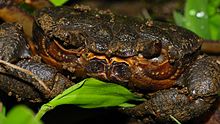Potamon ibericum
| Potamon ibericum | |
|---|---|

| |
| Scientific classification | |
| Domain: | Eukaryota |
| Kingdom: | Animalia |
| Phylum: | Arthropoda |
| Class: | Malacostraca |
| Order: | Decapoda |
| Suborder: | Pleocyemata |
| Infraorder: | Brachyura |
| Family: | Potamidae |
| Genus: | Potamon |
| Species: | P. ibericum
|
| Binomial name | |
| Potamon ibericum (Bieberstein, 1808)
| |
| Synonyms | |
|
Cancer ibericum Bieberstein, 1808 | |
Potamon ibericum is a
near threatened species on the IUCN Red List, and is included in the Red Data Book for Ukraine
.
Description
Potamon ibericum differs from other species in the genus in the form of the first
pleopod of the males – the organ used to transfer spermatophores. In P. ibericum, the flexible zone of this appendage is widest near the middle, rather than V-shaped (as in P. fluviatile and P. rhodium) or bilobed (as in P. potamios).[2]
Ecology and behaviour

The continued survival of P. ibericum generally requires a permanent body of water, although the crabs can survive short periods of drought by retreating under stones, or into deep burrows.[1] These burrows may be several kilometres from the nearest body of water.[3] They only breed in moving water, with copulation occurring in the warmer months, from June to October.[1]
Potamon ibericum is an omnivore, eating
European otter, Lutra lutra, alongside a variety of fish species.[4]
Distribution

The
isotherm.[3]
Potamon ibericum was introduced to the
gorges, in a part of the river that rarely dries out.[6] A second population was discovered in the 1990s, 300 km (190 mi) from the Cagne site, in the Hérault River near Saint-Guilhem-le-Désert. Neither population is considered invasive.[6] Another species of Potamon – P. fluviatile – has also been introduced to France, in the vicinity of Nice.[6]
predators of an extinct snail in the genus Melanopsis.[7]
Conservation
Despite its wide geographical range, P. ibericum is classified as
near threatened on the IUCN Red List, as "it is possible that populations of P. ibericum in parts of its range might be in danger of extirpation in the future, especially those on islands or near centres of human population on the mainland".[1] It may even approach a classification of vulnerable.[1] The species is listed in the Red Data Book for the Ukraine.[1]
References
- ^ . Retrieved 20 November 2021.
- ^ PDF). Biologia, Bratislava. 59 (2): 173–179.
- ^ PDF) on 2014-02-22. Retrieved 2011-09-23.
- PDF). IUCN Otter Specialist Group Bulletin. 23 (1): 5–11.
- ISBN 978-3-89104-482-7.
- ^ ISBN 978-1-4020-6028-1.
- PDF) on 2012-03-20. Retrieved 2011-09-23.
External links
 Media related to Potamon ibericum at Wikimedia Commons
Media related to Potamon ibericum at Wikimedia Commons- Potamon ibericum (Bieberstein, 1809), Pan-European Species directories Infrastructure

